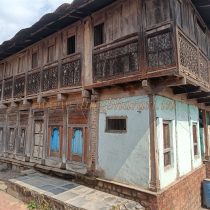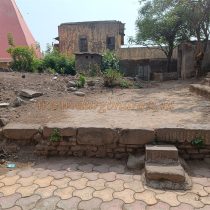BHOKARDAN
TYPE : FORTRESS
DISTRICT : JALNA
HEIGHT : 0
Bhokardan is a taluka located in Jalna district and is known as an old and historical city of Maharashtra. According to the local legend, its name may have been derived from the name of Bhogvardhan Raja to Bhokardan. The village is located on the Sillod-Jaffrabad road on the banks of Kelna River, 20 km from Sillod and 64 km from Aurangabad on the Ajanta route. In many documents published before 1980 AD, there are mentions of ruined ramparts around the old city, but now, in 2023, when exploring the city, no remains of the fort can be seen anywhere. A Nizam era fort known as “Lal Gadhi” can be seen in the old city of Bhokardan. As this part of Marathwada was under the control of the Nizam of Hyderabad, this fortress was used to collect the grain in the form of tax of the surrounding villages until India became independent. Currently Nandkumar Deshpande is living in this fortress and he says that his ancestors bought this fort from the Lad family during the Nizam period.
...
Called “Lad's Gadhi”, this fortress name later transformed and became “Lal Gadhi”. The facade of the fort has a carved stone arch of the door and two hexagonal bastions at either end. The lower part of both these bastions is built in stone and the construction above it is made of bricks. One of these bastions is partially collapsed. The inner area of the fortress is about half an acre and has a two storied Wada (big mansion) inside. This is a fortress built by a merchant for his private use and it has no history whatsoever. 10 minutes is enough to see the fortress. The place Bhokardan was located on the trade route from Ujjain to Paithan. It is mentioned in ancient literature as well as in the Markandeya Puran and many inscriptions. In ancient times it was a district and later it got the status of a subject i.e. a province. The inscriptions mention that residents of Bhogvardhan donated for the construction of Stupas at Sanchi and Bharhut. An inscription mentions that Kalchuri king Shankargan of Mahishmati donated land in a village in Bhogvardhan to a Brahmin. There is a Shaiva cave with seven rooms and a hall carved on the banks of the Kelna River around 8th-9th centuries AD, but the history of the village after that is unknown. Under the guidance of S. B. Dev and R.S. Gupte excavation was done here in 1973-74. Remains of many settlements of pre-Satavahana period, Satavahana period and post-Satavahana period were found in it. Bhokardan flourished due to India's trade with the Roman civilization during the Satavahan period. During the Satavahan period, the city was on an ancient trade route and was connected with the important cities of Ujjain and Paithan as well as cities like Junnar, Karle, Kanheri, and Kalyan etc. After the decline of the Satavahan dynasty, like Paithan, the town's trade with Rome may have slowed down and its opulence and importance gradually declined. Later in the medieval period, this city gained importance once again. During the Peshwa period, Marathwada was under the control of Nizam, therefore, Bhokardan village was also under his influence.
© Suresh Nimbalkar









